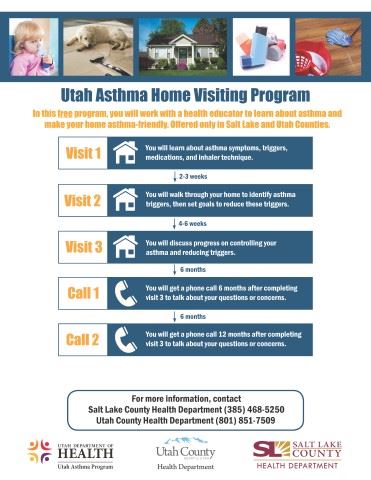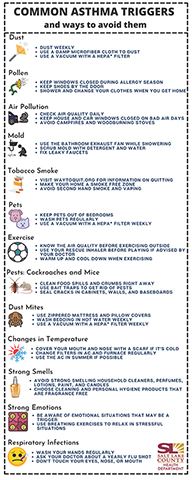Asthma
To contact the asthma program, call 385-468-5250, text 385-202-5178, or email asthma@slco.org.
About
Asthma is a lifelong lung disease that can make it hard to breathe. When a person has asthma, their airways are more sensitive to certain triggers. When a person is exposed to a trigger, their bronchioles (the airways in their lungs) react by producing mucous, tightening the muscles that go around the bronchioles, and the airways become narrower due to inflammation.
The Salt Lake County Health Department Asthma Program conducts a FREE home visiting program and provides asthma education for people of all ages living in Salt Lake County with uncontrolled asthma.
Home Visiting
Our FREE home-visiting program is for people of all ages with severe or uncontrolled asthma. You qualify for the program if you:
- Have been to the emergency room or hospital for asthma in the last year.
- Have been on oral steroids (like prednisone) in the last year for your asthma.
- Have an Asthma Control Test (ACT) score of less than 19.
Signs & Symptoms
Signs and symptoms of asthma are different for every person. Some of the most common symptoms of asthma are:
- Coughing
- Shortness of breath or difficulty breathing
- Wheezing
- Chest tightness or pain
- Waking up due to coughing or wheezing
A trigger is something that causes you to have asthma symptoms. There are many different triggers, but some of the most common are:
- Dust
- Pollen
- Air pollution (including inversion and smoke from wildfires)
- Mold
- Tobacco smoke (including second hand smoke and vaping)
- Pets (dander or skin flakes, saliva, urine)
- Exercise
- Pests (cockroaches, mice, dust mites, etc.)
- Changes in temperature
- Strong smells (perfume, household cleaners, etc.)
- Strong emotions (laughing or crying)
- Respiratory infections
Managing
Asthma is a chronic disease, which means it does not have a cure. It can, however, be controlled by taking your medications the right way and by avoiding asthma triggers. Taking your medications the right way means taking them on time and using the right technique. To be in control of your asthma is to live symptom free!
There are two main types of asthma medications:
- Controller (daily) medication:
- Prevents symptoms
- Reduces swelling in the airways
- Should be taken daily, even if you are feeling well
- Relief (or rescue) medication:
- Relieves symptoms
- Relaxes airway muscles and opens the airway
- Is taken when asthma symptoms first develop
Why Use a Spacer with Your Inhaler
Your asthma might not be as controlled as it could be if:
- You use your rescue inhaler at least two times a week
- You wake up coughing more than twice a month
- You refill your rescue inhaler more than twice a year
If you experience any of the above, having an asthma action plan may help. An asthma action plan is developed by you and your doctor. It can help you manage your asthma by knowing what medications to take and what triggers to avoid.
Resources
- American Lung Association
- Centers for Disease Control and Prevention - Asthma
- Current Utah Air Quality
- NIH Breathe Better
- Life of Asthma Mom
- Winning with Asthma (Training for coaches of kids with asthma)
- Utah Department of Health Asthma Program
- Asthma and Allergy Foundation
- EPS Asthma Resources
- About Asthma
- Asthma Community Network
- Find Asthma Support
- Medline Plus- Asthma






